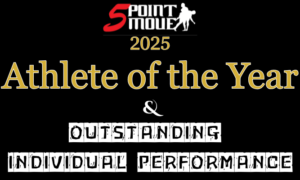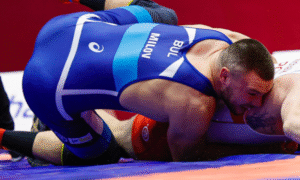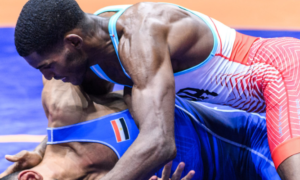It was the end of the first day of the 2016 Junior Greco Roman World Championships and there was some stock to take. Having just closed out the afternoon with two fresh, new bronze medalists, Team USA was sitting in an odd position — second place. Nine first round wins punctuated by medal-winning performances from Taylor LaMont (60 kg) and G’Angelo Hancock (96 kg) had launched the American squad into the somewhat unfamiliar role of potential party-crashers. With a different crop of would-be contenders stepping on the mat the next day, the perceived tide facing the US Greco Roman program appeared to be turning a whole lot faster than most could have anticipated.
Unfortunately, the second day would not be a repeat of the first. Outside of Nicholas Reenan’s hot start, they began to fall like dominoes. Jamal DeArmond lost a tense battle at 66; Michael Rogers (120 kg) was dominated in his first bout; Reenan got ousted in his quarterfinal; and Dalton Roberts (55 kg) dropped a close decision, erasing the US’s hopes to hold onto all of that momentum it had accrued the day before. Second place was long gone.
Eighth is where the US would finally finish up. Likely, the final team results at a glance might seem to be a disappointment, particularly coming off such a strong start the previous day. But context is key. In 2014, the US Junior Greco Roman team wound up 17th. Last year, it was a 14th place finish. That makes coming in eighth representative of a substantial uptick. It is also higher up on the leaderboard compared to where Armenia, Hungary, Ukraine ended up, all teams which had finished comfortably in front of the US in years prior.
Part of this improvement, naturally, has to do with the roster. Five members of the 2016 US Junior World Team are engaged in Greco Roman wrestling on a full-time basis (Randon Miranda, 50 kg; Dalton Roberts, 55 kg; Jamal DeArmond, 66 kg; Kamal Bey, 74 kg; and the aforementioned Hancock). Miranda, Roberts, and DeArmond are resident athletes at the Northern Michigan University/Olympic Training Site program while Bey and Hancock train in Colorado Springs. For his part, Hancock is also a member of the Senior National Team. Junior World Teams from the recent past have featured other wrestlers who had experienced their share of high-level domestic and international competition, only to move away from the style later on.

Miranda, a Northern Michigan-OTS athlete, went 1-2 at the Junior Worlds. (Photo: John Sachs)
The 2016 team also featured a few who are not bypassing collegiate competition in favor of more Greco, or at least not immediately. LaMont, who has been one of the country’s more dedicated and tenacious age-group competitors, is taking his talents to Utah Valley. Reenan and Rogers are both setting sail for North Carolina State. It goes without say that the US Greco Roman program would prefer to keep these athletes on the Greco path permanently, but decisions have already been made. LaMont, Reenan, and Rogers returning to Greco either following their folkstyle seasons or at the conclusion of their college careers altogether comes in as sort of a second-tier consolation prize, if that should be the case. The story is all-too familiar — age-group Greco wrestlers setting sail for the NCAA, Greco coaches hoping to see them again at some point in the future.
But the five who are currently all “Greco’ed up” aren’t going away anytime soon and this retention is recognized as a critical factor in ushering in a sturdy and more consistent program. Retention, after all, is obviously vital to overall development. To have a fighting chance overseas, not only do American wrestlers require ongoing adjustments to Greco, but they also need as many avenues for international competition as they can get. The overwhelming majority of these opponents (if not all of them) the Americans tangle with have been training and competing in Greco Roman since the first time they ever stepped on mat. That’s an awful lot of ground to make up but in the meantime, jumping into stateside action whenever it is available will have to do.
Roberts, DeArmond, and Bey have dipped their feet into the Senior level domestically, and as a collective will see more of that over the next year. Hancock, who at all of 19 years of age, put together a startlingly impressive 2016 campaign and is on the hook for even more overseas opportunities as a Senior. Progression. US National Team head coach Matt Lindland has made it a priority to bring in youth, cultivate it, and provide room for growth at every level. The program is a mere two years into this paradigm-shifting approach championed by Lindland, and has involved multiple combined training camps between Cadets, Juniors, and Seniors as well as more individualized plans related to the objectives of specific athletes. It is, in a word, encompassing. The results speak for themselves, so long as you are willing to accept that things can no longer be done the way the same they used to be anymore.
Microcosms are necessary when the overall view enters into the world of the abstract. What you had this week in Macon, France were two medals, ten wins, and five tournament participants who are devoted to continuing down the same path. Something is working. Outlooks have changed. There are more changes coming. It is never about one athlete or event, you have to see these things as reflections of the times more so than as the remnants of isolated moments. The bar has just been raised for the first time in quite a while. For the US, that is as encouraging as it gets.
















